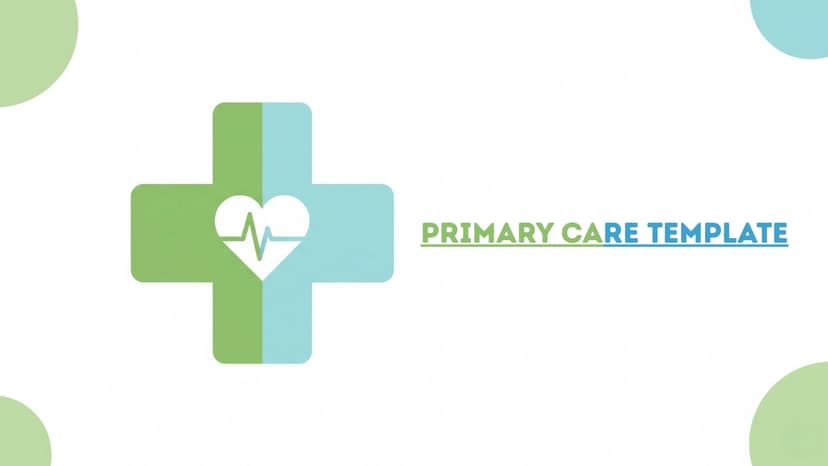Streamline ComprehensivePatient CareDocumentation
In primary care, clinicians manage a wide range of patient concerns. Our template simplifies your workflow, ensures accurate charting, and supports exceptional, continuous care.
All-in-One Format: This template helps providers capture patient history, preventive care, chronic conditions, and acute issues efficiently.

🧾 Why a Primary Care Template Matters
Primary care involves both breadth and continuity. A structured template is essential for managing chronic diseases, addressing new complaints, and coordinating preventive care.
Ensure No Detail is Overlooked
A comprehensive structure for both breadth and continuity of care.
Save Time During Documentation
An efficient format that reduces charting time during busy clinic days.
Standardize Clinical Notes
Improve collaboration and handoffs with clear, consistent team communication.
Comply with Billing Standards
Align documentation with EHR, quality metrics, and billing requirements.
Track Patient Progress
Effectively monitor chronic conditions and preventive care over time.
👩⚕️ Who Uses This Template?
Family Medicine Physicians
Internists
Nurse Practitioners (NPs)
Physician Assistants (PAs)
Geriatricians
Primary Care Clinics & Community Health Providers
🧩 Inside the Primary Care Template
Our template walks clinicians through a comprehensive but efficient format that works for any patient visit, from acute issues to chronic care management.
1. Chief Complaint (CC)
Document the primary reason for today’s visit in the patient's own words.
Example:
"Patient presents with fatigue and intermittent dizziness for 1 week."
2. History of Present Illness (HPI)
Detail the symptoms, duration, context, and any self-management attempts.
Example:
"Fatigue began 7 days ago, worsens with activity. No fever, weight loss, or chest pain."
3. Past Medical, Surgical, Family & Social History (PMFSH)
Capture relevant chronic conditions, surgeries, family risks, and lifestyle.
Include:
- Chronic illnesses (e.g., hypertension, diabetes)
- Surgeries or hospitalizations
- Smoking, alcohol, or drug use
- Exercise, diet, and living situation
Example:
"Patient has a history of hypertension, managed with Lisinopril. Non-smoker."
4. Medications & Allergies
Update current prescriptions, OTC meds, supplements, and known allergies.
Example:
"Lisinopril 10mg daily. Allergy: Penicillin (rash)."
5. Review of Systems (ROS)
Perform a focused or comprehensive review based on the chief complaint.
Example:
"CONSTITUTIONAL: Positive for fatigue. CARDIOVASCULAR: Negative for chest pain."
6. Physical Examination (PE)
Record objective findings from the physical exam.
Example:
"BP: 132/84, HR: 78. Lungs clear, no murmurs, no edema."
7. Assessment/Diagnosis
Document clinical reasoning and establish diagnoses with ICD-10 codes.
Example:
"1. Fatigue (R53.83), likely multifactorial. 2. Hypertension (I10), stable."
8. Plan of Care
Detail next steps, follow-ups, prescriptions, and patient education.
Include:
- Medications prescribed or adjusted
- Diagnostic tests ordered (e.g., CBC, ECG)
- Lifestyle counseling (e.g., sleep hygiene)
- Follow-up timeline and referrals
Example:
"Order labs (CBC, CMP, TSH), encourage hydration, follow-up in 1 week."
✨ Use Case Examples
Chronic Disease Follow-Up
Annual Wellness Visit
Acute Visit
🚫Common Pitfalls in Primary Care Notes
- !Copy-pasting old notes without verifying accuracy
- !Missing lifestyle factors (smoking, sleep, diet)
- !Generic assessments without clear clinical reasoning
- !Forgetting to document patient education in the plan
✅Best Practices for Effective Notes
- ✓Use brief, clear statements with bullet points
- ✓Tailor HPI and Plan to the visit type (acute, chronic, preventive)
- ✓Document shared decision-making with the patient
- ✓Ensure diagnoses in the Assessment are supported by S/O data
- ✓Write as if your note will be audited or handed to another provider
🛡️Legal & Billing Compliance
Our Primary Care Template supports:
- ✓CPT/ICD-10 alignment for billing accuracy
- ✓Audit-ready documentation for legal and insurance reviews
- ✓Supports risk stratification and quality metrics (e.g., HEDIS, MIPS)
- ✓Demonstrates ethical and regulatory compliance
Simplify Primary Care With SCRIBE AI
SCRIBE AI’s intelligent templates and AI-powered note suggestions help you focus more on your patients, not your paperwork, while maintaining the highest documentation standards.
Conclusion
Whether it’s an annual physical, chronic disease follow-up, or acute concern, your documentation should reflect professional excellence. The SCRIBE AI Primary Care Template gives you a trusted, fast, and compliant way to do just that. Start documenting smarter. Start with SCRIBE AI.